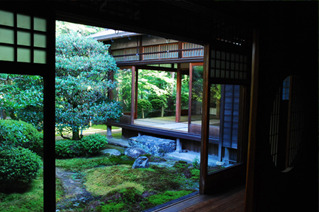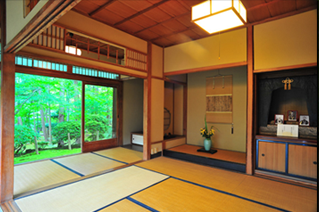
Kakkien has only one genkan, or traditional Japanese entryway. Although the combination of a Japanese-style building and a western-style building was not unusual for villas constructed in the early twentieth century, the two buildings were typically placed well apart from each other. In the few cases of villas with a Japanese- and a western-style building placed side by side, a separate genkan and approach for each building is the norm.
But at Kakkien, only the Japanese-style building has a genkan. In the course of combining Japanese and Western architecture from the Meiji era onward, the positioning of the genkan changed and no villas built before Kakkien feature a genkan only for the Japanese-style building. On the other hand, most Japanese residences built in the Taisho and Showa eras had a genkan, with a Western-style drawing room adjacent to it, and tatami rooms and a kitchen for everyday living situated at the rear of the house. In terms of its architectural conception, Kakkien anticipates such houses. Thus, Kakkien is considered to be a residence of architectural distinction, the first shining example of a hybrid architectural tradition combining the best of Japan and the West.
Jinbee Yagi, Jr., the master carpenter who constructed the Japanese-style building of Kakkien, is known for his expertise in sukiya-zukuri (“zukuri” meaning style). Sukiya-zukuri bloomed during the Meiji era, eschewing the formality emphasized by shoin-zukuri, a traditional Japanese architectural style originating in the Kamakura period (1185-1333), and aimed at creating simple spaces. In the Meiji era, many buildings were built using high-quality timber. In view of the newfound preference for the simplicity of sukiya-zukuri among those commissioning upscale residences, as opposed to the formality of shoin-zukuri, carpenters excelling in sukiya-zukuri achieved celebrity and many buildings in the sukiya-zukuri style were constructed throughout the country.
The carpenter Jinbee Yagi was a leading practitioner of sukiya-zukuri. He built several modern Japanese-style buildings affiliated with Sumitomo. Of them, Kakkien is perhaps the most minimalist in conception.


Yagi’s aesthetic intentions are fully expressed by the 10-tatami reception room, which is a highlight of this building. This room was used for entertaining guests. The toko (recessed alcove) has no nageshi (beam) and the tokowaki only has a raised floor and neither tenbukuto nor jibukuro (upper or lower cabinet with sliding doors) or staggered shelves. The shoinmado (window with paper screens) has muntins. Decoration is minimal.
Therefore one’s attention is drawn to the intrinsic attributes of the materials. The tokobashira (alcove post) is shibori maruta (naturally striated log) of Kitayama Sugi (cedar from the Kitayama district of Kyoto). The shelf of the tsukeshoin (exterior corner of the alcove) has exquisite tamamoku (circular burls). The grain of the wood itself is a source of fascination. Most impressive is the sugi maruta (cedar log) used for the nokigeta (pole plate) of the engawa (narrow wooden passageway facing the garden). The log is about 11 meters in length. No knots are visible and the framework is without the slightest distortion more than a century since its construction. Taruki (rafters) connected to the nokigeta are migaki maruta (polished logs). It must have been difficult to secure so many of them for just one building.
The construction agreement between Teigo Iba and Jinbee Yagi mandates the use of high-quality timber. Yagi sourced timber throughout Japan for use in this Japanese-style building. Using timber in its natural state requires expertise. The distinction of Yagi’s carpentry is evident in the perfect finishing without superfluous elaboration.
The interior redolent of unaffected naturally impeccable taste perfectly complements the view from the engawa, encompassing moss and maple leaves, presenting the unadorned beauty of nature.



Next to the 10-tatami reception room, the 6-tatami room, with its tokonoma and a Buddhist altar, was Iba’s living room until 1922 when the annex was built. Every morning Iba cooked porridge on the hibachi (brazier) and breakfasted in this room. After offering incense and praying before the Buddhist altar, he spent the day in the western-style building in summer and in this room in winter.
Proceeding along the corridor, one comes to the annex commissioned by Iba’s second eldest son Kanichi. Projecting into the garden, this 6-tatami room, featuring a tokonoma and a Buddhist altar, is bordered by a nine-tatami corridor. Two sides of the room overlook the garden, making it the room at Kakkien that is most open to the natural surroundings. At the engawa, there is a kutsunugi ishi (flat-topped stone where footwear is removed before entering the house) made of several stones cemented together, a rare design of that period.
Compared with Yagi’s work, the annex is somewhat more decorative. For example, the tokonoma has a katomado (literally “flower head window”). However, the use of high-quality timber is unchanged, such as Jomon Sugi (seasoned Yaku Sugi cedar from Yakushima Island in Kagoshima).
Perhaps reflecting Kanichi’s filial piety and consequent consideration for his father whose susceptibility to the cold increased with age, the room has a fireplace, which is unusual for a Japanese-style room. In his final years, this room was Iba’s favorite place from which to view the moon.




 EN
EN